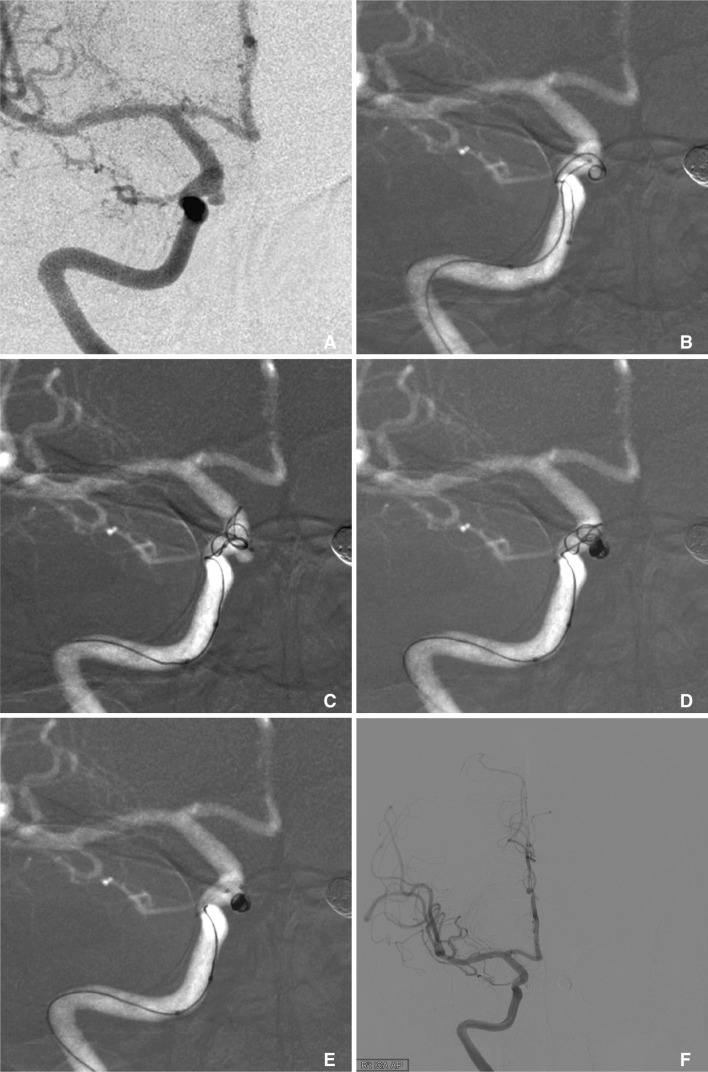Neurointervention.
2013 Sep;8(2):105-109. 10.5469/neuroint.2013.8.2.105.
Complex Coil Assisted Single Coil Embolization for Small Intracranial Aneurysm
- Affiliations
-
- 1Department of Radiology, Taitung Mackay Memorial Hospital, Taitung, Taiwan. onecowyang2@gmail.com
- 2Department of Radiology, China Medical University Hospital, Taichung, Taiwan.
- 3Department of Radiology, Chia-Yi Christian Hospital, Chia-Yi, Taiwan.
- 4Department of Radiology, E-DA hospital, Kaohsiung, Taiwan.
- 5Department of Radiology, Veteran General Hospital-Taichung, Taichung, Taiwan.
- 6Department of Radiology, Show-Tran general hospital, Changhua, Taiwan.
- 7Institute of Traditional Medicine, School of Medicine, National Yang-Ming University, Taipei, Taiwan.
- 8Department of Surgery, Taipei Mackay Memorial Hospital, Taipei, Taiwan.
- KMID: 1784027
- DOI: http://doi.org/10.5469/neuroint.2013.8.2.105
Abstract
- The purpose of the technical note is to introduce the complex coil assisted coil embolization method in the treatment of intracranial small aneurysm, in order to enhance the safety of the procedure. The first microcatheter was navigated into the aneurysm sac and the ultrasoft coil was used as the embolization coil. If the embolizations coil could not stay within the aneurysm sac smoothly, such as coil herniation into parent artery during the delivery process. The second microcatheter would be navigated to the aneurysm level in the parent artery. Another complex coil was delivered within the parent artery via the second microcatheter to provide the neck bridge effect in order to enhance the stability of embolization coil. Besides, the protection coil will not disturb the parent artery flow. While the embolization coil was put into the aneurysm sac smoothly under the help of complex protective coil, the protective coil was then withdrawn gently. We use the most magnified view, dual-plane approach simultaneously to observe the stability of embolization coil. The embolization coil would be detached without any evidence of coil motion or vibration. The new method could provide the physiological protective method, without leaving any protective device such as stent within the parent artery.
Keyword
Figure
Cited by 1 articles
-
Parent Artery Complex Coil Protection for Side-Branched Wide-Neck Aneurysms
Keisuke Sato, Hiroshi Aoki, Shinya Jinguji, Hiroki Seto, Tsutomu Kobayashi
Neurointervention. 2022;17(2):115-120. doi: 10.5469/neuroint.2022.00136.
Reference
-
1. Nguyen TN, Raymond J, Guilbert F, Roy D, Bérubé MD, Mahmoud M, et al. Association of endovascular therapy of very small ruptured aneurysms with higher rates of procedure-related rupture. J Neurosurg. 2008; 108:1088–1092. PMID: 18518708.
Article2. Cloft HJ, Kallmes DF. Cerebral Aneurysm Performation Complicating Therapy with Guglielmi Detachable Coils: A Meta-Analysis. AJNR Am J Neuroradiol. 2002; 23:1706–1720. PMID: 12427628.3. Goddard JK, Moran CJ, Cross DT III. Absent Relationship between the Coil-Embolization Ratio in Small Aneurysms Treated with a single Detachable Coil and Outcomes. AJNR Am J Neuroradiol. 2005; 26:1916–1920. PMID: 16155134.4. Yang MS, Wong HF, Yang TH. Alternative option in the treatment of very small ruptured intracranial aneurysms. Surg Neurol. 2009; 72(Suppl 2):S41–S46. PMID: 19944825.
Article5. Moret J, Cognard C, Weill A. The "remodeling technique" in the treatment of wide neck intracranial aneurysms: Angiographic results and clinical follow-up in 56 cases. Interv Neuroradiol. 1997; 3:21–35. PMID: 20678369.6. Nelson PK, Levy DI. Balloon-assisted coil embolization of wide-necked aneurysms of the internal carotid artery: medium-termangiographic and clinical follow-up in 22 patients. AJNR Am J Neuroradiol. 2001; 22:19–26. PMID: 11158882.7. Soeda A, Sakai N, Sakai H, Iihara K, Yamada N, Imakita S, et al. Thromboembolic events associated with Guglielmidetachable coil embolization of asymptomatic cerebral aneurysms: evaluation of 66 consecutive cases with use of diffusion-weighted MR imaging. AJNR Am J Neuroradiol. 2003; 24:127–132. PMID: 12533341.8. Sorteberg A, Sorteberg W, Aagaard Beverly DL. Hemodynamic versus Hydrodynamic Effects of Guglielmi Detachable Coils on Intra-Aneurysmal Pressure and Flow at Varying Pulse Rate and Systemic Pressure. AJNR Am J Neuroradiol. 2004; 25:1049–1057. PMID: 15205147.
- Full Text Links
- Actions
-
Cited
- CITED
-
- Close
- Share
- Similar articles
-
- Microcatheter-assisted Coil Embolization of Distal Vertebral Artery Wide-Necked Aneurysm: A Case Report
- Ferromagnetic Artifact Due to Metallic Embolic Fragment after Endosaccular Coil Embolization: A Case Report
- Single-session Coil Embolization of Multiple Intracranial Aneurysms
- Spontaneous Occluded Anterior Communicating Artery Aneurysm during Coil Embolization Treated with One Coil Insertion into Remaining Stump
- Combined Endovascular and Microsurgical Procedures as Complementary Approaches in the Treatment of a Single Intracranial Aneurysm


